Exam Details
Exam Code
:HP0-Y51Exam Name
:Building HP SDN and FlexNetwork SolutionsCertification
:Master ASEVendor
:HPTotal Questions
:60 Q&AsLast Updated
:Mar 29, 2025
HP Master ASE HP0-Y51 Questions & Answers
-
Question 51:
An administrator plans to deploy a wireless network, which might need to support a mix of 802.11g and 802.11n clients in the 2.4 GHz frequency. The administrator wants to prioritize transmissions for 802.11 n clients. Which 2.4 GHz radio setting helps to prevent slow clients from taking more than their share of transmission time?
A. Set up the channel reuse option.
B. Set up the fair scheduling option.
C. Set the mandatory data rate for 802.11g as low as possible.
D. Set the multicast data rate for 802.11n as low as possible.
-
Question 52:
Table of Acronyms
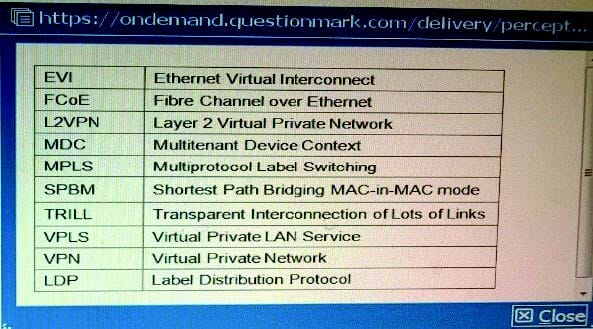
Refer to the exhibit.
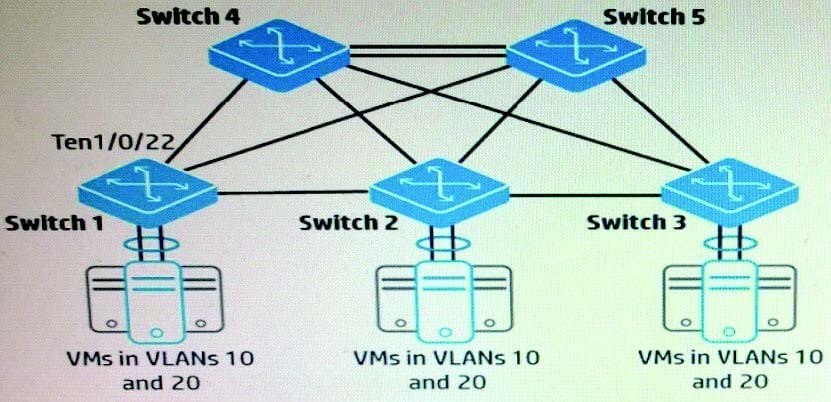
The switch shown in the exhibit should from a TRILL region. For Switch 1 interface ten1/0/22, what is a valid port link-type and TRILL port type?
A. port link type = access port in any VLAN TRILL port type = TRILL access port
B. port link type = access port in any VLAN TRILL port type = TRILL trunk port
C. port link type = trunk port that permits VLMs 10 and 20 TRILL- port type = TRILL access port
D. port link type = hybrid port with untagged VLANs 10 and 20 TRILL port type = TRILL hybrid port
-
Question 53:
Table of Acronyms Refer to the exhibit.
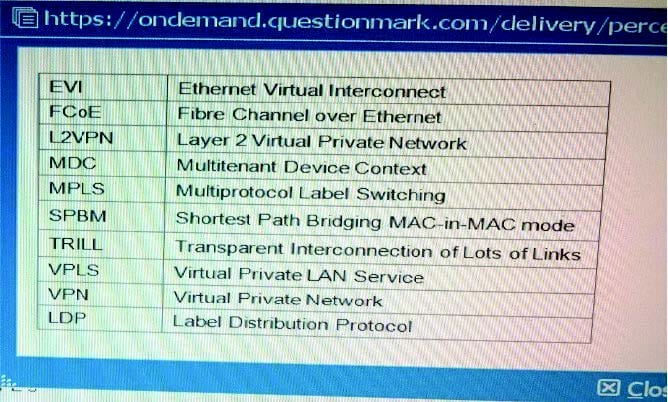

An administrator is planning an MPLS and VPLS Martini to connect customer sites 1, 2, and 3. How many pseudo must the administrator define?
A. Two-two on PE-1, with one connected to PE-2 and PE-3
B. Three-one each on PE-1, PE-2, and PE-3
C. Four-two on PE-1, one on PE-2 m and one on PE-3
D. Six-two each on PE-1, PE-2, and PE-3
-
Question 54:
Table of Acronyms
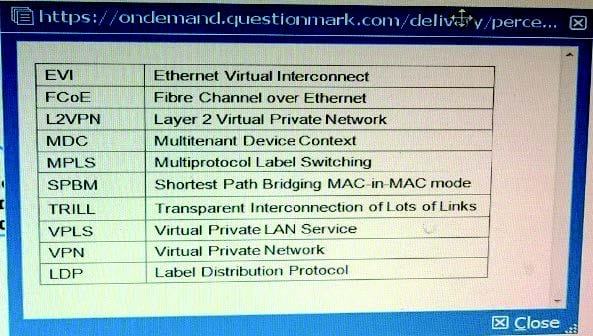
Refer to the exhibit
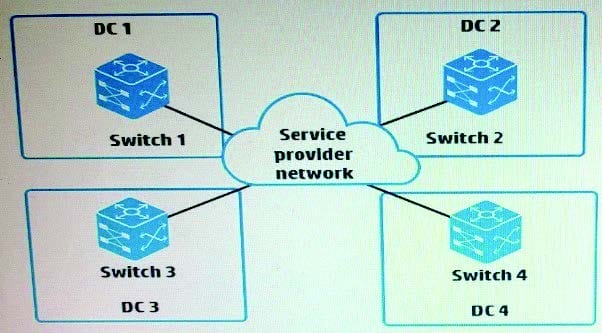
An administrator wants to connect four data centers using HP EVI. What is the correct setup for the EVI tunnel interfaces?
A. Three EVI tunnel interfaces on each EVI edge device-one EVI tunnel interface is required for each GRE tunnel in the mesh
B. One EVI tunnel interface on Switch 1, which will be configured as the ENDP server, and no interfaces on the other switches
C. Three EVI tunnel interfaces on Switch 1, which will act as the hub. and one EVI tunnel interface each on the other switches
D. One EVI tunnel interface on each EVI edge device--the devices automatically establish GRE tunnels between these interfaces
-
Question 55:
Table of Acronyms Exhibit 1

Exhibit 2 The switches shown in the exhibit are implementing SPBM. The administrator is now setting up interface ten1/0/1 to connect to a new VMware host. What is the correct port type and VLAN assignment for the interface?
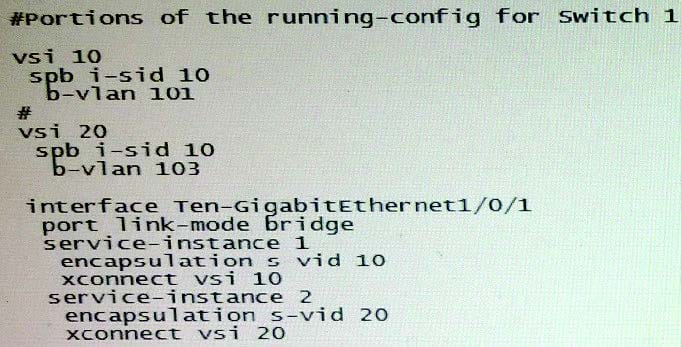
A. Trunk port than permits VLANs 101 and 103
B. Hybrid port than permits VLANs 201 and 203
C. Trunk port that permits VLANs 10 and 20
D. Access port that permits the default VLAN
-
Question 56:
Refer to the exhibit.
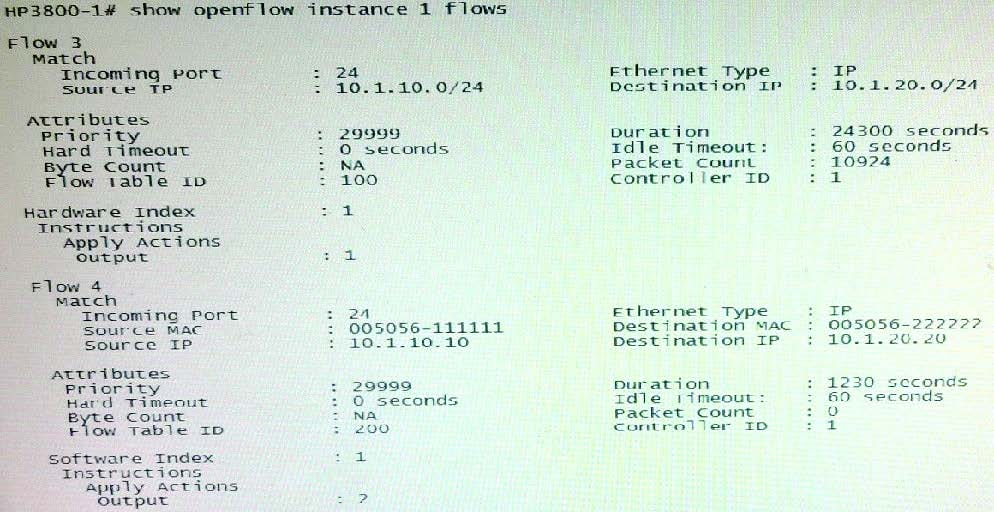
An HP provision switch has OpenFlow table entries indicated in the exhibit.
The switch should forward most traffic between 10.1.10.0/24 and 10.1.20.0/24 on port 1. However any IP traffic between server 1, at 005056-111111 and
10.1.10.10, and server 2, at 005056-222222 and 10.20.20, should be forwarded on port 2.
Which change to the rules let the switch behave as desired?
A. For flow 3, the table ID is set to 200, and the priority is set to 47000
B. For flow 4, the priority is set to 47000
C. For flow 4, the table ID is set to 100, and the priority is set to 47000
D. For flow 3, the instruction is set to Write Actions output 1
-
Question 57:
A company is deploying an HP Unified Wired-Wireless controller solution with an HP BYOD solution. Guests will connect to an open Guest SSID and be redirected by their default gateway to a portal hosted by User Access Manager (UAM). The default gateway is a Comware routing device.
The administrator has set up portal authentication on the Comware device to implement the redirect. The administrator asks the BYOD solution designer about the correct RADIUS and domain settings for portal authentication on the switch. What should the BYOD solution designer explain to the administrator?
A. The administrator does not need to make any changes as long as the switch is managed by IMC. UAM will automatically access the managed switch and configure the correct settings.
B. These settings are not necessary because the UAM BYOD portal automatically handles the authentication and then forces the guest to reconnect the SSID and authenticate with MAC-Auth.
C. The RADIUS scheme and domain must be configured with the same settings that would be used for traditional portal authentication to UAM. In addition, the RADIUS scheme must use the standard server type.
D. The RADIUS scheme and domain must be configured with the same settings that would be used for traditional portal authentication to UAM. In addition, the RADIUS scheme must enable transparent MAC authentication.
-
Question 58:
Table of Acronyms
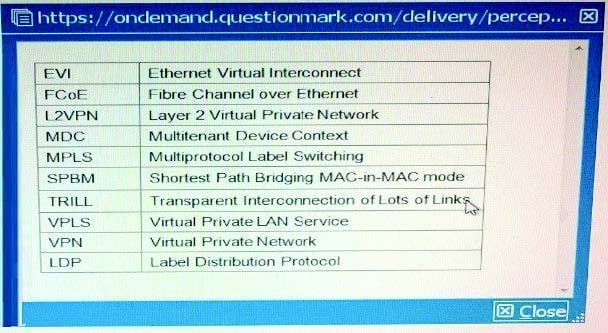
An HP Comware switch is configured with the MDC feature. It has three MDCs, which use the same CPU and are assigned these CPU weights:
MDC 1 = 10
MDC 2 = 4
DC 3 = 2
Currently:
MDC 1 needs to use 25 percent of the CPU resources.
MDC 2 needs to use 60 percent of the CPU resources.
MDC 3 needs to use 60 percent of the CPU resources.
Approximately what percentage of the CPU does each MDC receive while at the current CPU request rates?
A. MDC 1 = 25 percent, MDC 2 = 50 percent, and MDC 3 = 25 percent
B. MDC 1 = 63 percent, MDC 2 = 25 percent, and MDC 3 = 12 percent
C. MDC 1 = 10 percent. MDC 2 = 4 percent, and MDC 3 = 2 percent
D. MDC 1 = 25 percent. MDC 2 = 25 percent, and MDC 3 = 12 percent
-
Question 59:
An administrator sets up an OpenFlow instance on an HP Provision switch in passive mode. What does this mean?
A. The switch first attempts to switch or route traffic using its own MAC forwarding and routing tables. If it does not know how to treat the traffic, it uses the OpenFlow table.
B. The switch does not associate this OpenFlow instance with a specific VLAN Instead VLANs that are not assigned to another OpenFlow instance are associated with this instance.
C. The switch matches all traffic in the instance against an OpenFlow table, but, if it finds no match, it forwards the traffic normally
D. The switch does not forward any traffic in the instance locally. Instead, it encapsulates all traffic in OpenFlow Packeket_Out messages to the controller.
-
Question 60:
Refer to the exhibit.
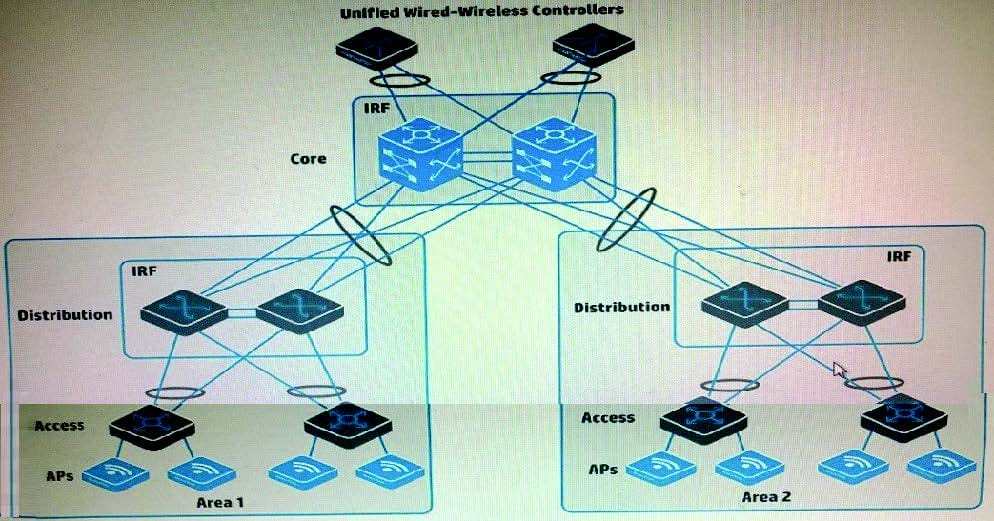
A company has HP APs that are managed by the two Unified Wired-Wireless controllers. Wireless users use Wi-Fi Protected access (WPA2) and authenticate with 802.1X to HP Access Manager (UAM). The SSID uses centralized forwarding. Users need to be able to roam seamlessly from area 1 to area 2.
Which step helps to meet these needs?
A. Configure local forwarding for the SSID on both controllers.
B. Configure controller 1 as a backup controller for APs in area; configure controller 2 as a backup controller for APs in area1.
C. Change the security mode to preshared key (PSK) and enable opportunistic key change (also called "fast roaming").
D. Set up enable a roam that includes both controllers.
Tips on How to Prepare for the Exams
Nowadays, the certification exams become more and more important and required by more and more enterprises when applying for a job. But how to prepare for the exam effectively? How to prepare for the exam in a short time with less efforts? How to get a ideal result and how to find the most reliable resources? Here on Vcedump.com, you will find all the answers. Vcedump.com provide not only HP exam questions, answers and explanations but also complete assistance on your exam preparation and certification application. If you are confused on your HP0-Y51 exam preparations and HP certification application, do not hesitate to visit our Vcedump.com to find your solutions here.